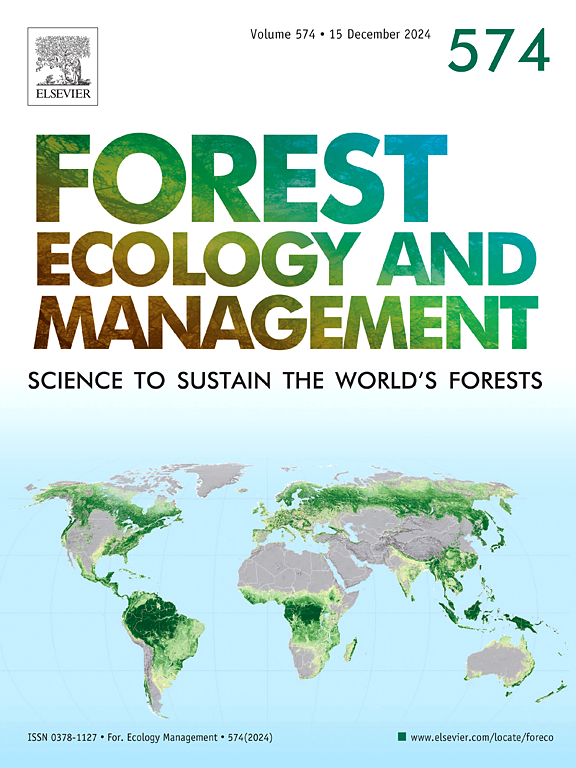加强GEDI在巴基斯坦对比森林中的地上生物量密度估算
IF 3.7
2区 农林科学
Q1 FORESTRY
引用次数: 0
摘要
森林被认为是减缓气候变化的关键资源,因为它们以森林生物量的形式捕获和储存二氧化碳。最近,地面森林清查数据和空中和地面光探测和测距(激光雷达)提供的详细植被结构数据的增加,使森林生物量的大规模评估受益。然而,地面和机载激光雷达数据都很昂贵,对许多国家来说都不可行。相比之下,自2019年以来,星载全球生态系统动力学调查(GEDI)激光仪器收集了全球温带和热带森林的公开数据。GEDI波形与使用全球现场数据网络校准的模型相结合,以生产生物质产品。然而,在GEDI目前的校准数据集中,南亚森林中可用的野外样地相对较少。我们在此表明,在巴基斯坦两种不同的森林生态系统(即常绿阔叶树和针叶树的山林和沿海红树林)中,使用GEDI数据和野外样地(594)战略性校准的本地模型可以增强GEDI的地上生物量密度(AGBD)统计估计值。在轨GEDI AGBD估计在山区的RMSE为95 Mg/ha / 87 %,而在红树林地区的RMSE为8.4 Mg/ha / 89 %。GEDI山区的AGBD估计值始终低估了AGBD较高地区(300 Mg/ha)的现场测量值,而高估了AGBD较低地区(50 Mg/ha)的现场测量值。相比之下,利用野外测量数据重新校准的本地生物量模型的RMSE在山区为39.6 Mg/ha / 36 %,在红树林为4.1 Mg/ha / 39 %。在缺乏最新的NFI测量或缺乏足够参考数据的司法管辖区,GEDI是AGBD估计的宝贵辅助资源。然而,使用现场数据进行局部校准可以提高准确性和精度,特别是在基本模型具有稀疏的局部校准数据的地区。然后,GEDI的改进估计值可以与主动和被动卫星数据一起用于区域AGBD制图,并降低NFI采样覆盖率低的区域的不确定性。本文章由计算机程序翻译,如有差异,请以英文原文为准。
Enhancing GEDI above ground biomass density estimates in contrasting forests of Pakistan
Forests are considered a critical resource for climate change mitigation because they capture and store carbon dioxide in forest biomass. Large-scale assessments of forest biomass have benefited recently from the increasing availability of ground-based forest inventory data and detailed vegetation structural data from airborne and terrestrial light detection and ranging (LiDAR). However, both terrestrial and airborne LiDAR data are costly, and not feasible for many nations. In contrast, since 2019, the spaceborne Global Ecosystem Dynamics Investigation (GEDI) laser instrument has collected publicly available data for global temperate and tropical forests. GEDI waveforms in conjunction with models calibrated using a worldwide network of field data to produce biomass products. However, relatively few field plots are available in the forests of South Asia in GEDI's current calibration dataset. We show here that GEDI's statistical estimators of Above Ground Biomass Density (AGBD) can be enhanced using local models calibrated strategically with GEDI data and field plots (594) in two contrasting forest ecosystems (i.e., mountain forests with evergreen broadleaf and needle-leaf trees, and coastal mangroves) in Pakistan. On-orbit GEDI AGBD estimations in mountainous areas have an RMSE of 95 Mg/ha / 87 % whereas estimates in mangrove areas have an RMSE of 8.4 Mg/ha / 89 %. GEDI AGBD estimates in mountain regions consistently underestimate field measurements in regions with higher AGBD (>300 Mg/ha), and overestimate in regions with low AGBD (<50 Mg/ha). In contrast, the locally recalibrated biomass models using the field measured data return RMSE of 39.6 Mg/ha / 36 % in mountain regions and 4.1 Mg/ha / 39 % in mangroves. GEDI is a valuable auxiliary resource for AGBD estimates in the absence of updated NFI measurements or over jurisdictions lacking enough reference data. However, local calibration using field data can increase accuracy and precision, particularly in areas where the base models have sparse local calibration data. Improved estimates from GEDI could then be used with active and passive satellite data for regional AGBD mapping and to lower uncertainties in regions with low NFI sampling coverage.
求助全文
通过发布文献求助,成功后即可免费获取论文全文。
去求助
来源期刊

Forest Ecology and Management
农林科学-林学
CiteScore
7.50
自引率
10.80%
发文量
665
审稿时长
39 days
期刊介绍:
Forest Ecology and Management publishes scientific articles linking forest ecology with forest management, focusing on the application of biological, ecological and social knowledge to the management and conservation of plantations and natural forests. The scope of the journal includes all forest ecosystems of the world.
A peer-review process ensures the quality and international interest of the manuscripts accepted for publication. The journal encourages communication between scientists in disparate fields who share a common interest in ecology and forest management, bridging the gap between research workers and forest managers.
We encourage submission of papers that will have the strongest interest and value to the Journal''s international readership. Some key features of papers with strong interest include:
1. Clear connections between the ecology and management of forests;
2. Novel ideas or approaches to important challenges in forest ecology and management;
3. Studies that address a population of interest beyond the scale of single research sites, Three key points in the design of forest experiments, Forest Ecology and Management 255 (2008) 2022-2023);
4. Review Articles on timely, important topics. Authors are welcome to contact one of the editors to discuss the suitability of a potential review manuscript.
The Journal encourages proposals for special issues examining important areas of forest ecology and management. Potential guest editors should contact any of the Editors to begin discussions about topics, potential papers, and other details.
 求助内容:
求助内容: 应助结果提醒方式:
应助结果提醒方式:


